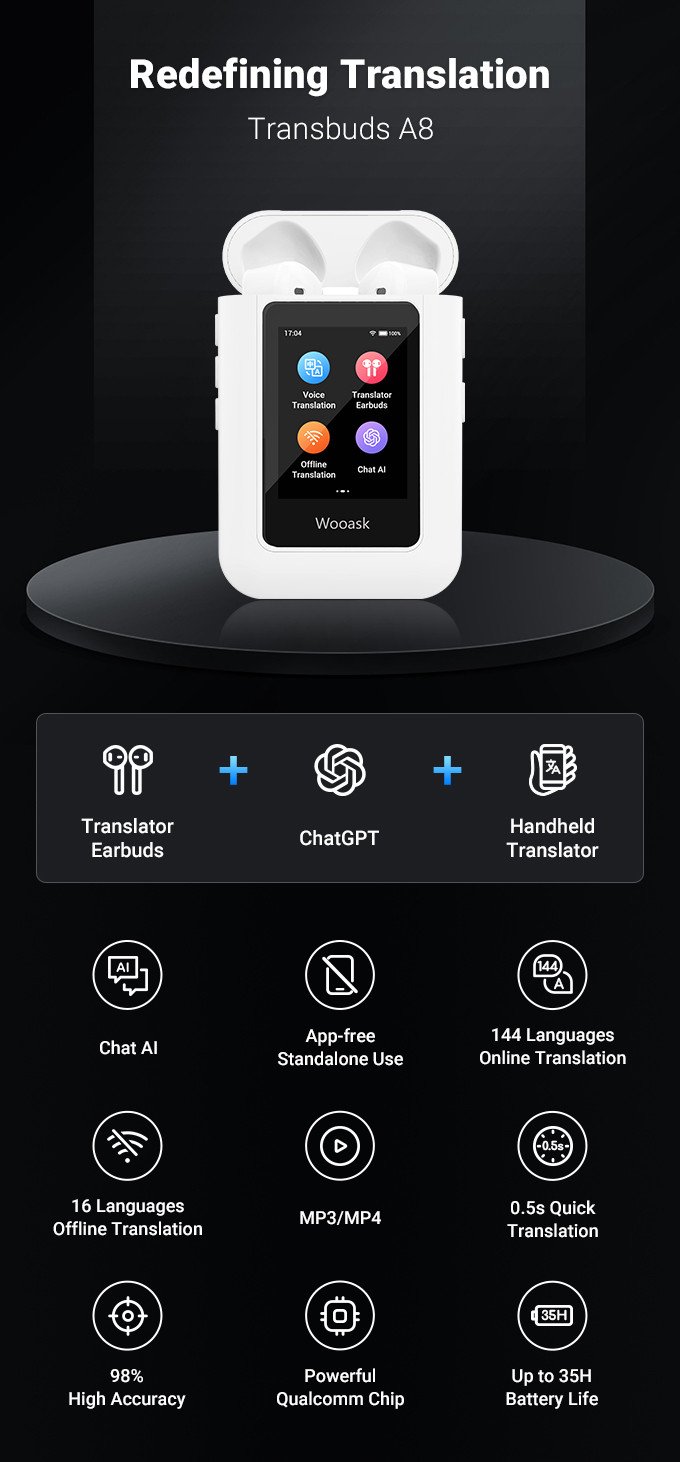Do Translation Earbuds Really Work

The Rise of Portable Translator Earbuds
In our increasingly interconnected world, communication is more important than ever. Whether you’re a globetrotter exploring exotic destinations, a business professional navigating international meetings, or someone just trying to understand a new friend, language often stands as the biggest hurdle. Enter portable translator earbuds , sleek, smart devices promising to tear down language barriers in real-time.
But how effective are they, really? Do translator earbuds actually work as advertised? Which models deliver on their promises? Do they come with hidden costs like monthly fees? And do you need to rely on an app to use them? This article dives deep into the world of translator earbuds, demystifying the technology and helping you decide if they’re worth your investment.
The Dream of Seamless Translation
Imagine walking through the bustling streets of Tokyo, intrigued by a vendor selling a local delicacy. You don’t speak Japanese, and the vendor doesn’t speak English. You nod politely, feeling a bit lost. But then, you put on a pair of translator earbuds, and suddenly, you can understand each other. The vendor’s Japanese is translated into English in your ear, and your English responses are translated back into Japanese for him. The experience feels like something out of a science fiction movie , but it’s real.
This is the promise of portable translator earbuds: real-time, hands-free, and bidirectional communication. They use advanced AI-powered translation algorithms, speech recognition, and wireless connectivity to translate conversations almost instantly.
But how well do they perform in the real world?
Do Translator Earbuds Really Work?
The short answer is: yes, they work , but with caveats.
Translator earbuds can translate dozens of languages with surprising accuracy, especially for commonly spoken ones like English, Spanish, Mandarin, French, German, and Japanese. They’re powered by AI and machine learning technologies that are constantly improving. Some models, like the Timekettle WT2 Edge or Google Pixel Buds, offer near-instantaneous translation with natural-sounding speech.
However, there are limitations:
-
Context and colloquialisms: While earbuds can handle standard conversations well, they may struggle with slang, idioms, or complex sentences.
-
Noisy environments: In loud settings, speech recognition might falter, reducing translation accuracy.
-
Internet dependency: Many translator earbuds require a stable internet connection for full functionality. Offline translation is often limited to a few languages or basic phrases.
-
Delay: There is usually a slight pause (1–3 seconds) during translation, which can disrupt the flow of natural conversation.
Despite these constraints, for everyday travel, casual conversations, and even some professional settings, translator earbuds work remarkably well and are only getting better with time.
How to Use Translator Earbuds
Using translator earbuds is simpler than you might think. Here’s a general step-by-step guide on how they work:
1. Charge and Pair the Earbuds
Start by fully charging your translator earbuds. Then, pair them with your smartphone using Bluetooth, just like you would with standard wireless earbuds.
2. Install the Companion App
Most translator earbuds require a companion app (like Timekettle, Google Translate, or WT2 Plus) for full translation features. The app allows you to:
-
Select the languages to be translated
-
Choose translation modes (simultaneous, consecutive, listen-only, etc.)
-
Update firmware and access offline translation packs
3. Choose a Translation Mode
Most earbuds offer several translation modes:
-
Simul Mode: Both users wear an earbud and speak normally; translations are delivered to each other in real time.
-
Touch Mode: Tap the earbud to begin speaking; the translation plays in the other person’s earbud or phone speaker.
-
Speaker Mode: Only one person wears earbuds; translations play aloud through the phone for others to hear.
-
Listen Mode: One-way translation of announcements, lectures, or monologues (great for travelers).
4. Start the Conversation
Once the settings are configured, simply start speaking. The earbuds will automatically recognize your voice, translate it, and play it in the selected language. Most systems are designed to be hands-free after setup.
Which Earbuds Can Translate Languages?
There’s a growing number of translation earbuds on the market, but only a few truly stand out for their performance, features, and reliability. Here are some top-rated options:
1. Timekettle WT2 Edge
-
Supported Languages: Over 40 languages and 93 accents
-
Offline Capability: Yes, with downloadable language packs
-
Translation Modes: Simul, Touch, Speaker
-
Highlights: Highly rated for natural conversation flow and minimal delay. No need to pass phones back and forth. Great for immersive experiences.
2. Google Pixel Buds Pro
-
Supported Languages: 40+ via Google Translate
-
Offline Capability: Limited
-
Translation Modes: Real-time with Google Translate on Android
-
Highlights: Deep integration with Android devices. Excellent sound quality. Requires internet for most functions.
3. WT2 Plus
-
Supported Languages: Similar to WT2 Edge
-
Offline Capability: Yes
-
Translation Modes: Multi-person, Simul, Speaker
-
Highlights: Affordable alternative to the Edge. Slightly older but still robust.
4. Anfier Language Translator Earbuds
-
Supported Languages: 40+
-
Offline Capability: Some offline use
-
Translation Modes: Two-way and listen
-
Highlights: Budget-friendly, decent performance for the price.
5. JoveTrans Lite
-
Supported Languages: 26+
-
Offline Capability: Limited
-
Translation Modes: Real-time
-
Highlights: Stylish and good for casual travelers.
When choosing translation earbuds, consider your priorities: Do you need offline translation? Will you be using them in loud environments? Are you fluent in tech, or do you prefer plug-and-play simplicity? These questions will help narrow down your options.
Is There a Monthly Fee for Translation Earbuds?
This is a common and important question. Here’s the breakdown:
Free vs Paid Translation
-
Free Features: Most translation earbuds include free basic translation services via their app, including real-time translation, multiple language support, and conversation modes.
-
Offline Packs: Some earbuds, like Timekettle, charge a one-time fee for downloading offline language packs. These do not require ongoing subscriptions.
-
Premium Services: Some brands offer subscription tiers for more accurate or advanced translation features, including:
-
Improved AI engines
-
More language packs
-
Voice-to-text transcription
-
Cloud storage for conversations
-
The Bottom Line:
You do not need to pay a monthly fee to use most translator earbuds. However, advanced features or offline functionality may require a one-time purchase or optional subscription. Always check the fine print before buying.
Do You Need an App for Translation Earbuds?
In almost every case, yes , an app is required. The earbuds themselves are only part of the system; the heavy lifting (translation, voice recognition, interface) is handled by a smartphone app.
Here’s why the app matters:
-
Language selection and customization
-
Download offline packs
-
Software updates
-
Translation modes and user settings
Without the app, most earbuds will function like standard wireless headphones, but you won’t get access to translation capabilities.
Popular translation apps include:
-
Timekettle App (for WT2 models)
-
Google Translate (works with Pixel Buds)
-
JoveTrans App
-
Anfier App
The apps are usually free, though some offer premium upgrades. Compatibility with Android and iOS is generally standard, though the experience may vary between platforms.
Real World Use Cases
✈️ Travel
Language translator earbuds are perfect for travelers. Ask for directions, order meals, negotiate prices, and connect with locals without relying on outdated phrasebooks.
👨💼 Business
Use them in international meetings, trade shows, or video conferences. Real-time translation can bridge cultural gaps and speed up negotiations.
🧑🏫 Education
Ideal for exchange students or language learners who want real-time comprehension during lectures or conversations.
👩⚕️ Healthcare
In medical settings, translator earbuds can assist communication between doctors and patients who don’t speak the same language , a powerful tool in emergencies.
The Future of Translation Earbuds
AI-driven translation is evolving rapidly. Soon, we can expect:
-
Faster processing with 5G and edge computing
-
More natural translations through deep learning
-
Expanded offline support for low-connectivity regions
-
Augmented reality integration for immersive translations
As earbuds become more compact and intelligent, we may reach a point where they seamlessly integrate into daily life , turning Star Trek-style universal translators from fiction into fact.
Should You Buy Translator Earbuds?
If you’re someone who travels frequently, works with international teams, or simply loves connecting with people from different cultures, translator earbuds are worth serious consideration.
They’re not perfect, but the best models offer impressive translation capabilities that make them incredibly useful. Just remember to:
-
Choose a reputable brand
-
Understand app and connectivity requirements
-
Be aware of optional fees for offline features
Ultimately, translator earbuds represent more than just a tech gadget , they’re a step toward a more connected, inclusive world where language is no longer a wall but a bridge.
Have you tried translator earbuds yet? What was your experience? Drop your comments and let’s discuss how technology is changing the way we communicate. image/kickstarter





